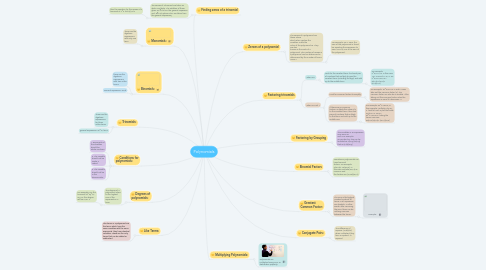
1. Monomials:
1.1. These are the algebraic expressions with only one term.
2. Binomials:
2.1. these are the algebraic expressions with two unlike terms.
2.2. General expression: ax+b
3. Trinomials:
3.1. These are the algebraic expressions for three unlike terms
3.2. general expression: ax^2 +bx+c
4. Conditions for polynomials:
4.1. 1. Exponents of the variables should be whole numbers.
4.2. 2. The variable should not be inside a radical
4.3. 3. The variable should not be in the denominator.
5. Degrees of polynomials:
5.1. The degree of a polynomial refers to the highest sum of the exponents in a term.
5.1.1. For Example: For the trinomial 3x^2y^2+ 5x+12, the degree will be 2+2= 4
6. Like Terms:
6.1. Like terms in a polynomial are the terms which have the same variables with the same exponents. they have identical variables. These are the only terms that can be added or subtracted
7. Finding zeros of a trinomial
7.1. The zeroes of a trinomial are taken as alpha, and beta. The addition of these gives: α+β=-b/a in the general expession and αβ=c/a {where a,b,c are taken from the general expression}
7.1.1. thus the equation for the zeroes of a trinomial is x^2 -b/a (x)+c/a
8. Multiplying Polynomials:
8.1. Polynomials are multiplied using FOIL or distributive property.
9. Conjugate Pairs:
9.1. The difference of squares: (a+b)(a-b), when multiplied, they form a squared - b squared
10. Greatest Common Factor:
10.1. The GCF is the highest number by which all terms in an expression are divisible. In other words, after removing the GCF, there can be nothing common between the terms.
10.1.1. Example:
11. Binomial Factors
11.1. Sometimes, polynomials can have binomial factors. For example: 6(2x+3)+ 2x(2x+3). in this case, we take (2x+3) as common and the factors are: (6+2x)(2x+3)
12. Factoring by Grouping
12.1. The variables in an expression may serve as GCF. For example: ax+ay+bx+by. This can be factored as: a(x+y)+b(x+y) that is, (a+b)(x+y)
13. Factoring trinomials
13.1. When a=1
13.1.1. Look for the constant term, find such pair of numbers that multiply to give the constant term (including the sign) and add up to the middle term
13.1.1.1. For example: x^2+7x+12. in this case, 12= 4*3 and 7= 3+4. So, x^2+3x+4x+12= x(x+3)+4(x+3)= (x+3)(x+4).
13.2. When a is not 1
13.2.1. Look for common factors to simplify
13.2.1.1. For example: 3x^2+6x+9. In such a case take out the common factor (3). The common factor can also be a variable. After taking out the common factor, solve the expression as usual if a becomes =1
13.2.2. If there are no common factors, multiple the value of a to the constant term. then find pairs of numbers that multiply to that term and add up to the middle one.
13.2.2.1. For example: 2x^2+5x+2; in this example, multiply 2 by 2= 4. look for such a pair that adds up to 5 i.e. 4x+x= 2x^2+4x+x+2. taking the terms common, 2x(x+2)+(x+2)= (2x+1)(x+2)
14. Zeroes of a polynomial
14.1. The zeroes of a polynomial are those values which when replace the variables, make the value of the polynomial=0. They are also known as the roots of a polynomial. The number of zeroes in a polynomial can be determined is determined by the number of terms minus 1
14.1.1. For example: 2x-4. Here, the zero of the polynomial is found be equating the expression to zero: 2x-4=0; x=2 is the zero of the polynomial.

